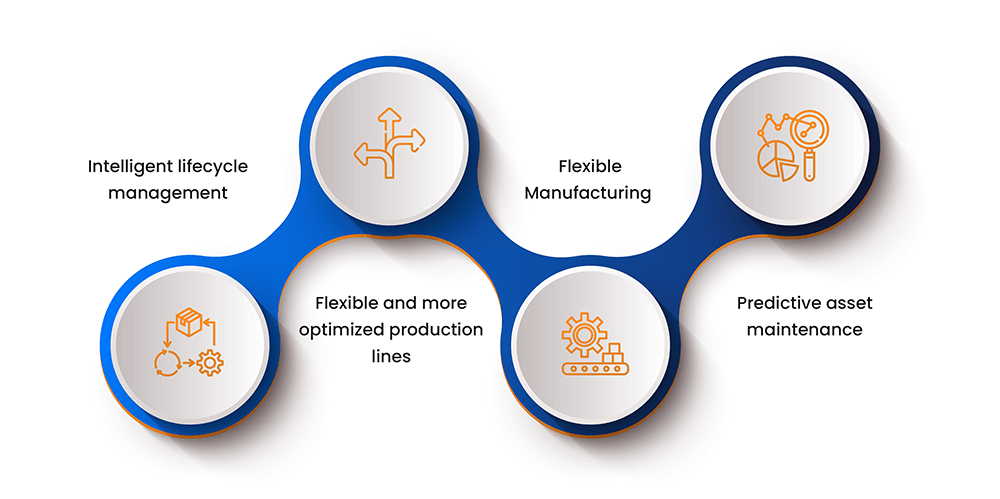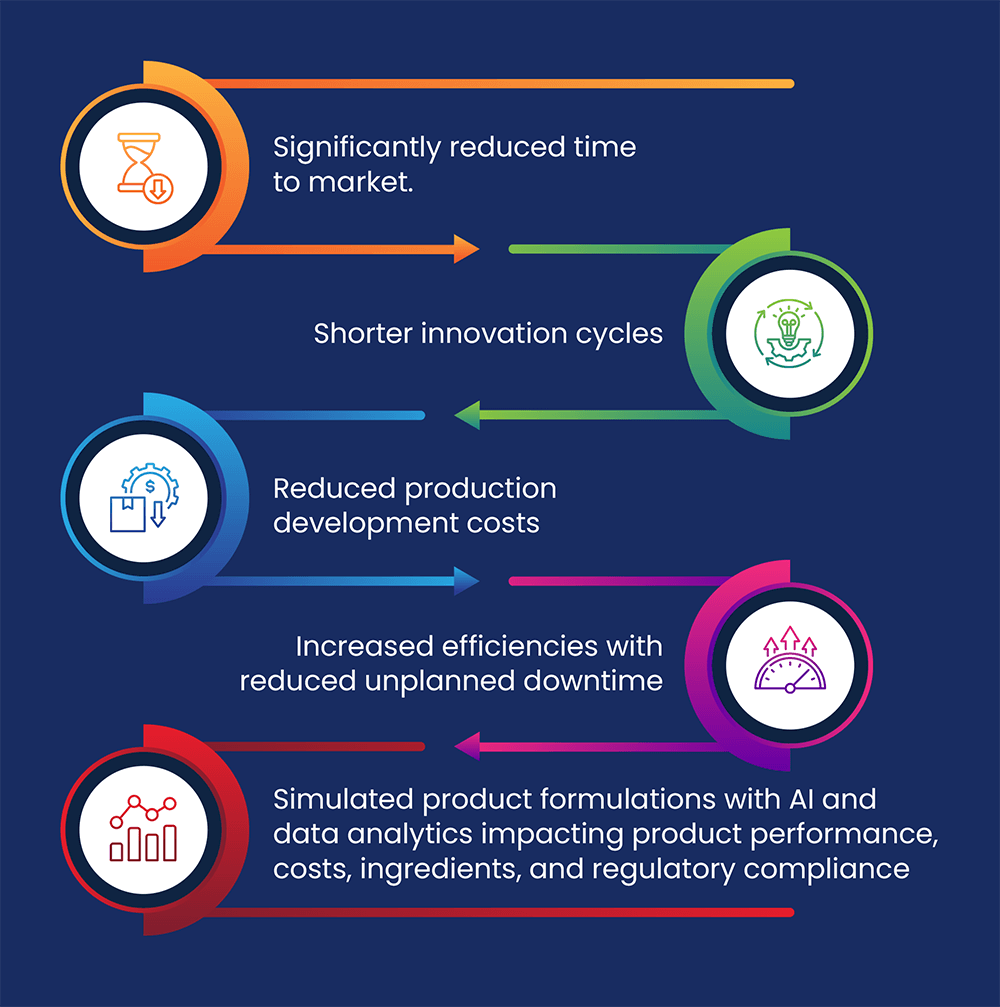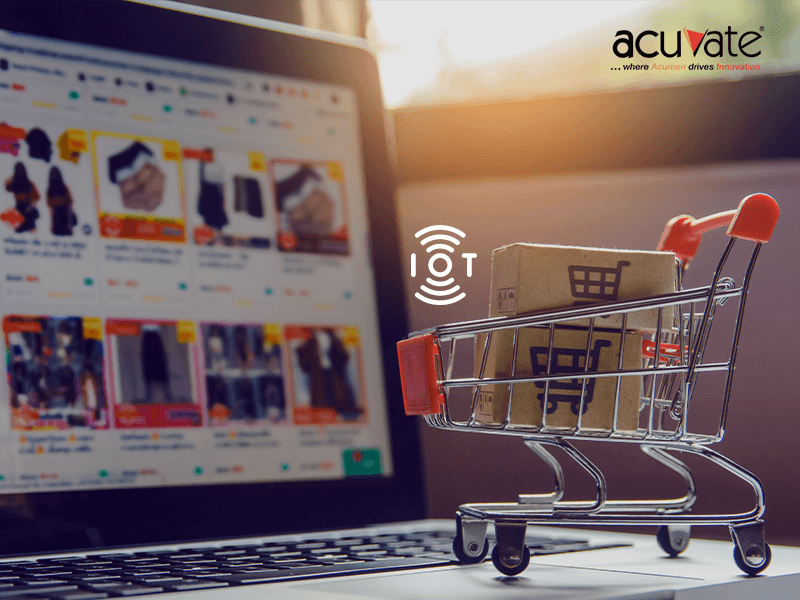The demographics and dynamics of CPG consumers’ aspirations are changing and becoming increasingly personalized, environmentally conscious, and available immediately. Seasonal and economic environments are leading to significant variations in demand, a new competitive landscape is evolving with respect to digital technology transformation, and new regulations and standards are keeping CPG industries on their toes.
Characterized by high pace, low margins, and extremely tight competition, CPG companies must safely and sustainably deliver products that provide exceptional experiences and delight customers. In short, to survive and grow, CPG brands must take cognizance of ROI requirements by designing and operating supremely efficient, high-speed production lines.
Due to the complexity of products and production operations, CPG leaders are slowly turning towards the latest digitalization trends and modern production processes and practices to run asset-intensive production lines effectively. CPG leaders are driving digital strategies for their customers to transform into experience-based businesses with the opportunity to lower product and production costs, build and improve robust digital supply chains, elevate the in-store experience, and improve customer loyalty.
Not new to the energy sector, the digital twin concept has been slowly making its foray into asset management for the CPG sector. Powered by AI and cloud technology, digital twins leverage digital data generated by various assets to enable proactive asset monitoring and maintenance and lower asset management costs.
IDC predicts that by 2025, half of the manufacturers will have networked linked product and asset digital twins into digital twin ecosystems for a systems-level view of their business and a 5% reduction in quality expenses.
Within asset management in CPG using Digital Twins, dual opportunities have emerged within the market, A) for plant design and build and B) during asset performance and maintenance. In short, both the data-driven rendering of assets and the building of a more agile and resilient production infrastructure fall under the gambit of asset management using Digital Twins in the CPG arena.
What is a Digital Twin?
As a static model, a virtual copy of a physical asset, a digital twin encompasses data pertaining to an asset’s physical properties and associated underlying processes. Since it is intended as a digital replica of the asset, it is crucial to have real-time data associated with the virtual model as a dynamic digital twin to allow it to update alongside changes in the physical asset. The dynamic model has all the relational data available in real-time, from the installation or commissioning of the asset to its retire or decommissioning.
As such, the core elements of a digital twin include the following:
- A 3D model and principle algorithm that lays out the physical attributes of the real-world asset.
- Changes in the asset over a specific period from as built to as modified, including historical data for what-if simulation coupled with real-time data for on-the-spot production optimization.
Digital twins for asset management fall into two fundamental categories:
- Project digital twins that leverage 3D to build futuristic, agile, and productive plant and equipment designs.
- Performance digital twins that capitalize upon cloud-based real-time data and analytics to optimize asset operations and maintenance.
Utilizing Digital Twins for Asset Management in CPG
In asset management in the CPG industry, digital twins offer a central repository for assets and their information, enabling operational efficiency by ensuring asset data is available to all stakeholders as a single source of truth. As a cloud-based solution that offers the ability to conduct simulations using historical asset data, digital twins help predict future changes in asset operations, allowing predictive maintenance & enabling efficient upgrades and replacement.
This creates a digital thread, i.e., a connected framework of data flows that produce a holistic and integrated view of an asset throughout its lifecycle.
Consumer Packaged Goods (CPG), like beverages, food items, and cosmetics, are typically fast-selling items driven by low-cost, high-quality, and exceptional speed-to-market. As such products need to be produced in large volumes to survive, it is vital to invest in technologies that ensure the viability and profitability of production processes. Here is where digital twins come into the picture, especially for factories, manufacturing units, and production lines.
Digital twins contain all information that constitutes operations of the production line, so in a scenario where production needs to be increased, individual assets and processes and systems of system assets that control production can be assessed and modified virtually, creating several what-if scenarios that can be evaluated to determine the feasibility. This also eliminates the long cycles of cross functional teams set up for decision making which is more people dependent. With Digital twin, the information resides digitally, and with AI anomaly detections, quicker and more accurate decisions can be made for optimized production lines.
Asset Management in CPG using Digital Twins: Use Cases

Intelligent lifecycle management
Intelligent lifecycle management integrates the various structures that describe the product over time, namely, as planned, as designed, as built, as tested, and as shipped. Digital twins integrate models, configurations, drawings, designs, and risks associated with the product, enabling expedited and more accurate decision-making.
Flexible and more optimized production lines
Profitable production necessitates highly efficient, flexible, and optimized production lines. Digital twins enable factories to run simulations of production lines, model factory equipment and combine results with 3D CAD models to verify design alternatives based on cost, uptime, and throughput.
Flexible Manufacturing
The traceability of data is crucial within production lines and factories. As consumer trends change and needs evolve, production lines must be agile enough to adapt to modular designs quickly and cost-effectively. As data is traceable and accessible across the entire production chain, the digital thread enables product changes to be implemented faster, bringing more flexibility to manufacturing processes.
Predictive asset maintenance
With the amalgamation and integration of data around performance and asset configuration, digital twins enable predictive and proactive asset maintenance, forecasting potential asset issues to allow corrective action — upgrade, repair, or replacement. This reduces unplanned downtime and unnecessary scheduled maintenance and improves production processes.
Asset Management in CPG using Digital Twins: Benefits
The global digital twin market was valued at USD $16.75 billion in 2025 and is forecast to reach a value of USD 53.5 Billion by 2028.
Indeed, production waste, equipment malfunctions, and unplanned downtime have a significant impact on manufacturers, and they are looking at ways to cut back losses and drive innovation in manufacturing.
Digital twins are offering a slew of benefits in this arena, helping CPG firms secure an edge in the market with the following:
- Significantly reduced time to market.
- Shorter innovation cycles
- Reduced production development costs
- Increased efficiencies with reduced unplanned downtime
- Simulated product formulations with AI and data analytics impacting product performance, costs, ingredients, and regulatory compliance

Intelligent data-driven smart manufacturing with Acuvate
Acuvate helps CPG brands optimize overall equipment efficiency (OEE) and reduce waste with digital manufacturing, aggregating data from disparate data sources to provide real-time analytics, predict breakdowns, and take corrective action.
A consumer goods company co-headquartered in the United Kingdom and one of the oldest multinational companies with a presence in over 190 countries had challenges with respect to:
- Optimizing throughput and utilization.
- Planned and ideal production time.
- Monitoring and improving OEE.
- Increase Output reliability.
- HR labor productivity monitoring
Our solution:
Acuvate implemented a Digital Twin solution on the Azure platform with reports built-in Power BI with a self-service data model. Data related to OEE loss, OEE loss classification, HR labor, and Output reliability was captured in the Digital Twin Model. IoT sensors were used to automate the end-to-end data-capturing process with no human intervention.
Built on Microsoft’s Azure Digital Twin and modern business Intelligence suite with reporting in Power BI, the solutions help the business understand the OEE loss type, work on improving the OEE of assembly lines, and increase the quality.
Outcomes:
- Increase in 20% OEE for some of the manufacturing units.
- Improved process robustness leading to dollar saving in OPEX.
- Direct and indirect labor productivity improved.
- ~1500 person-hours per month saving with automated reporting
How can Acuvate help?
At Acuvate, we help manufacturing firms build and deploy data-driven smart manufacturing solutions that improve overall OEE and reduce waste. As a one-stop-shop solution for end-to-end manufacturing, we also incorporate digital twin solutions into our package for CPG firms with a fast 12-16 weeks time to market.
We have proven expertise in the CPG domain, having worked with reputed names such as Unilever and ABInBev for more than a decade, with successful rollouts of prescriptive analytics and dashboards.
Learn more on integrated digital twin solutions by Acuvate and KDI: Integrated Digital Twin Solutions by Acuvate and KDI.
Solutions can be deployed with very little to no modifications to the existing legacy IT landscape to deliver Proof of Value and scale.
To know more about our solution, schedule a personalized consultation with our experts.



